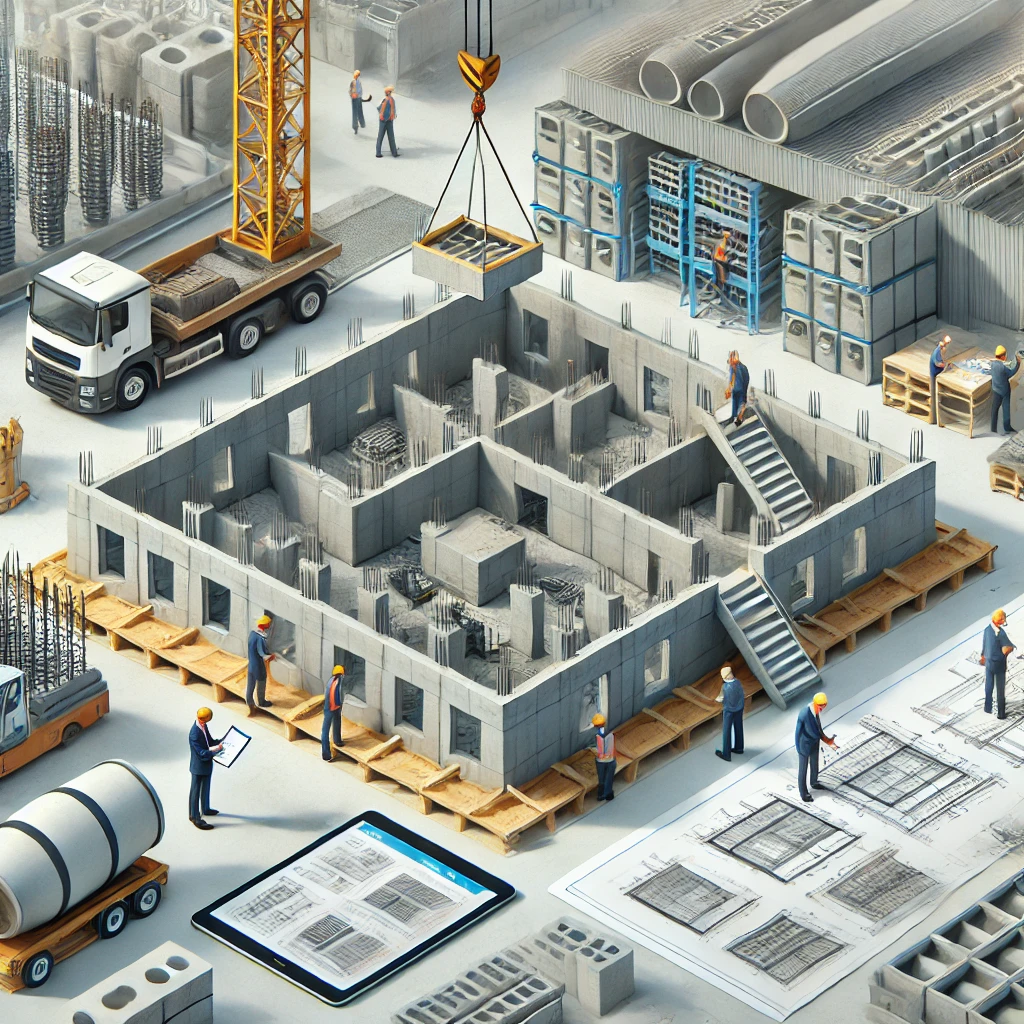Introduction to Precast Concrete Detailing
Precast concrete detailing is an essential aspect of modern construction, involving the design, modeling, and production of prefabricated concrete elements. These elements are manufactured off-site in a controlled environment and then transported to the construction site for assembly. This approach enhances efficiency, reduces construction time, and ensures high-quality standards.
Unlike traditional cast-in-place concrete, precast concrete offers better durability, precision, and consistency. It is widely used in residential, commercial, and infrastructure projects, providing flexibility in design while improving overall project efficiency.
Key Components of Precast Concrete Detailing
Precast concrete detailing includes various structural elements, each playing a crucial role in construction:
- Precast Panels and Slabs – Used for floors, walls, and roofing systems, these elements provide structural stability and insulation benefits.
- Precast Beams and Columns – Commonly used in multi-story buildings and bridges, offering superior load-bearing capacity.
- Precast Walls and Facades – Used in architectural and structural applications, providing both functional and aesthetic value.
- Connection Detailing – Critical for ensuring seamless assembly of precast elements, using components like dowels, bolts, and welded joints.
Advantages of Precast Concrete in Construction
Precast concrete detailing brings numerous advantages to the construction industry:
- Speed and Efficiency – Manufacturing precast elements off-site significantly reduces construction timelines, minimizing on-site labor requirements.
- Durability and Strength – Precast concrete is designed to withstand heavy loads, harsh weather conditions, and long-term wear and tear.
- Cost-Effectiveness – Reduced material wastage, labor costs, and maintenance expenses contribute to overall cost savings.
- Sustainability Benefits – By optimizing material use and reducing on-site emissions, precast concrete aligns with green building practices.
The Precast Concrete Detailing Process
The process of precast concrete detailing involves several critical steps to ensure accuracy, efficiency, and structural integrity. Each phase plays a vital role in the overall success of a precast project.
- Design and Modeling – Precast concrete detailing begins with precise design and modeling, where engineers and architects create detailed plans using specialized software. These models ensure proper dimensions, reinforcement placement, and connection details.
- Shop Drawings and Approvals – Detailed shop drawings are prepared and reviewed by stakeholders, including contractors and engineers. These drawings serve as a blueprint for manufacturing and installation.
- Manufacturing and Quality Control – Precast elements are cast in a controlled factory environment, ensuring uniformity and superior quality. Quality control measures, such as strength testing and dimensional checks, are conducted before shipment.
- Transportation and Installation – Once manufactured, precast elements are transported to the construction site. Proper handling techniques and careful installation ensure a seamless assembly of components.
Software Used for Precast Concrete Detailing
Technology plays a significant role in precast concrete detailing, enhancing precision and efficiency. The most commonly used software includes:
- Tekla Structures – A leading BIM (Building Information Modeling) software that enables 3D modeling, detailing, and clash detection.
- AutoCAD and Revit – Widely used for drafting and 3D visualization of precast components.
- Allplan and BIM-Based Tools – Advanced tools that facilitate collaborative workflows, minimizing errors and enhancing coordination.
These software solutions improve the accuracy of precast detailing, reduce manual errors, and streamline project execution.
Challenges in Precast Concrete Detailing
Despite its advantages, precast concrete detailing comes with its own set of challenges:
- Handling Complex Designs – Creating intricate architectural details and custom shapes requires advanced design expertise and specialized tools.
- Coordination with Other Trades – Ensuring alignment with electrical, plumbing, and HVAC systems can be challenging, requiring precise coordination.
- Site Logistics and Transportation – Transporting large precast elements safely to the construction site demands careful planning and logistics management.
Overcoming these challenges requires experience, collaboration, and the use of advanced design technologies.
Best Practices for Effective Precast Concrete Detailing
To ensure a seamless precast concrete detailing process, professionals must adhere to industry best practices. These include:
- Standardization of Components – Using standardized designs and dimensions improves efficiency and reduces production costs. Prefabricating modular elements also simplifies assembly and ensures compatibility.
- Ensuring Accurate Shop Drawings – High-quality, detailed shop drawings prevent errors during manufacturing and installation. Proper annotation of dimensions, reinforcement details, and connection points is essential.
- Collaborating with Architects and Engineers – Close coordination between structural engineers, architects, and contractors ensures that all design aspects align with project requirements and building codes.
Following these best practices enhances quality, minimizes errors, and improves overall project efficiency.
Applications of Precast Concrete in Construction
Precast concrete is widely used across various construction sectors due to its versatility and durability. Some of its key applications include:
- Residential and Commercial Buildings – Precast panels, columns, and slabs are commonly used in apartment complexes, office buildings, and shopping malls, providing cost-effective and efficient solutions.
- Infrastructure Projects – Bridges, tunnels, and highways rely on precast elements for durability and fast construction timelines.
- Industrial and Warehouse Structures – Precast concrete is ideal for large-scale industrial buildings and warehouses, where strong structural integrity is essential.
The adaptability of precast concrete makes it a preferred choice for both private and public sector projects.
Role of BIM in Precast Concrete Detailing
Building Information Modeling (BIM) has revolutionized precast concrete detailing by improving collaboration, accuracy, and efficiency. Some benefits of BIM in precast detailing include:
- Clash Detection and Coordination – BIM tools allow professionals to identify and resolve clashes between precast elements and other building systems before construction begins.
- Improved Visualization – 3D modeling helps stakeholders visualize the final structure, reducing misinterpretations and design errors.
- Streamlined Project Execution – BIM facilitates seamless data sharing among project teams, leading to faster decision-making and reduced construction delays.
By integrating BIM technology, precast concrete detailing becomes more precise, efficient, and cost-effective.
Future Trends in the Precast Concrete Industry
The precast concrete industry is evolving rapidly, incorporating new technologies and innovations to enhance efficiency and sustainability. Some key trends shaping the future of precast concrete detailing include:
- Digital Fabrication and Automation – Advances in automation and robotics are revolutionizing precast manufacturing, reducing human error and increasing production speed.
- 3D Printing of Precast Elements – The use of 3D printing technology allows for the creation of complex and customized precast components with minimal material waste.
- Sustainable Materials and Green Precast – The industry is shifting toward eco-friendly solutions, including recycled aggregates, carbon-neutral cement, and energy-efficient production processes.
These innovations are set to improve construction efficiency while reducing environmental impact.
FAQs on Precast Concrete Detailing
- How does precast detailing improve efficiency?
Precast detailing ensures precise design and manufacturing, reducing on-site construction time and minimizing material wastage. - What factors influence the cost of precast concrete?
Costs depend on design complexity, transportation logistics, material selection, and production efficiency. - What are the common mistakes to avoid in precast detailing?
Errors in shop drawings, misalignment of connection points, and lack of coordination with other trades can lead to costly delays.
Conclusion
Precast concrete detailing plays a crucial role in modern construction, offering efficiency, durability, and sustainability. By leveraging advanced design software, following industry best practices, and adopting emerging technologies like BIM and automation, professionals can optimize precast projects for success.
Learn about Top Exhibition Booth Construction in Hannover for Trade Shows



